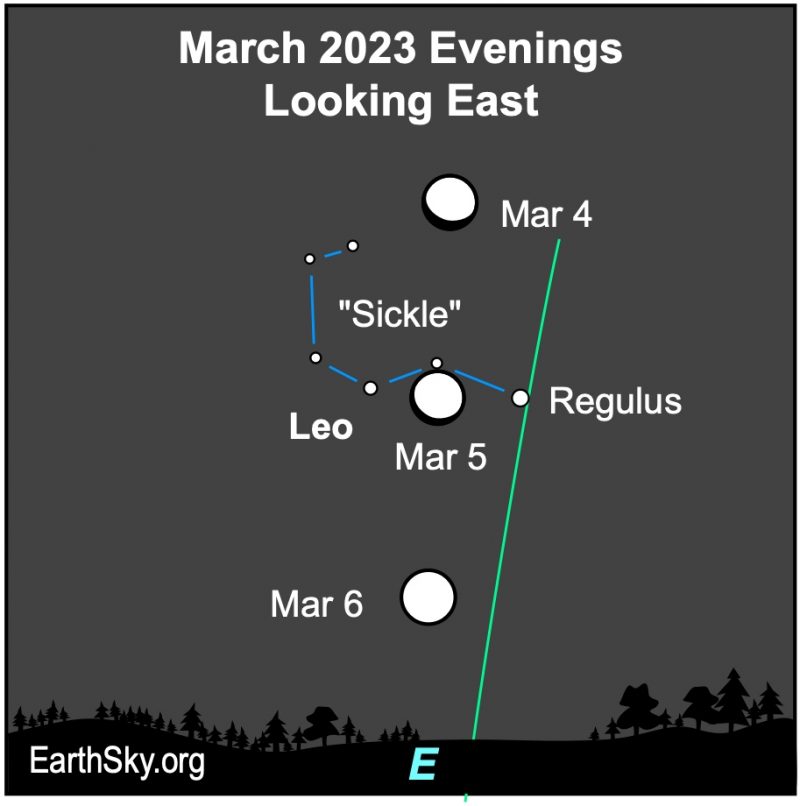
March full moon on the night of March 6-7

The full moon on March 6-7, 2023, is the closest full moon to the equinox on March 20. It’ll lie near the star Regulus in the constellation Leo.
March full moon
When to watch in 2023: Night of March 6-7.
Where to look: Look for the bright round moon in the east in the evening, overhead around midnight, and in the west before sunrise. It is visible all night.
Crest of the full moon falls at 12:40 UTC on March 7, 2023. That’s 6:40 a.m. CST in central North America. So if you live in central North America, your fullest moon will come around dawn on March 7, 2023.
It’s also the Worm Moon: All the full moons have popular nicknames. Popular names for the March full moon are Worm Moon, Crow Moon and Sap Moon. The name Worm Moon honors the stirring of earthworms and insect larvae in the slowly warming late winter and early spring soil.
Note: The moon will look full and round for a day or two around full moon. This is the closest full moon to the March equinox.

Last chance to get a moon phase calendar! Only a few left.
Opposite a Harvest Moon
The March 6-7 full moon is the closest full moon to 2023’s March equinox, which will fall at 21:24 UTC on March 20.
It’s the spring equinox for the Northern Hemisphere. And it’s the autumn equinox for the Southern Hemisphere. So for us in the Northern Hemisphere, the March full moon shows characteristics opposite those of a Harvest Moon. Meanwhile, in the Southern Hemisphere, this full moon has all the Harvest Moon characteristics.
Read: Full moon names by month and by season
What are the Harvest Moon’s characteristics?
We in the Northern Hemisphere have a tradition of full moon names. We use the term Harvest Moon for the full moon nearest the autumn equinox, in September or October.
And many of the full moons do have unique, seasonal characteristics. For example, all full moons rise at or around sunset. And – because the moon moves eastward in orbit – the moon typically rises about 50 minutes later with each passing day. But, around the time of the Harvest Moon, there’s only a short lag time between successive moonrises. The lag time between successive moonrises reaches a yearly minimum. For instance, at and around 40 degrees south latitude – around the time of the March full moon – the moon rises only about 30 to 35 minutes later daily.
The short time between successive moonrises continues for several days. So – around the time of the autumn equinox, and the Harvest Moon – there’s a bright full-looking moon in the early evening sky for several evenings in a row.
And that’s a Harvest Moon.
March full moon characteristics
In the Northern Hemisphere, in many years, the March full moon is the closest full moon to our spring equinox. So the lag time between successive moonrises reaches a yearly maximum. In other words, there’s an especially long time between moonrises, from one night to the next, around the time of the March full moon.
For instance, at 40 degrees north latitude, the moon rises some 75 minutes later from one night to the next, around the time of the March full moon. The longer-than-usual time between successive moonrises continues for several days. So – around the time of the spring equinox and the March full moon – there’s a longer-than-usual period of darkness (no moon) in early evening, for several days in a row following the date of full moon.
Arc of March full moon
And it’s not just moonrise times. It’s also the height of the moon’s arc across our sky that varies from month to month, and season to season. Every full moon rises in the east, as the sun sets in the west. Every full moon arcs across the sky throughout the night, and sets around dawn. For us in the Northern Hemisphere, the arc of this March full moon is lower than the paths of the full moons of December, January and February.
For those in the Southern Hemisphere, the full moon’s arc across the sky is climbing higher with each successive month. And then, it’ll continue to do so until around the June solstice.
Before the advent of artificial lighting, our ancestors must have been well aware of these seasonal vagaries of our wayward moon.
March full moon in Leo
The full moon on the night of March 6-7, 2023, is located in the direction of the constellation Leo. It glows near Leo’s brightest star, Regulus – said to represent the Heart of the Lion – and the star Denebola, in the Tail of the Lion. Denebola is the western member of the asterism called the Spring Triangle.
March full moons and Easter
The March full moon sometimes sets the date of Easter Sunday, but not in 2023. In 2023, we have a full moon in early March, and another full moon in early April. Easter comes on the first Sunday following the full moon after the March equinox. So the April full moon – on the night of April 5-6, 2023 – sets the date of Easter Sunday (April 9, 2023).
Read: When is Easter? And how is Easter tied to the night sky?

Bottom line: The 2023 March full moon is near two bright stars in Leo the Lion on the night of March 6-7.





























